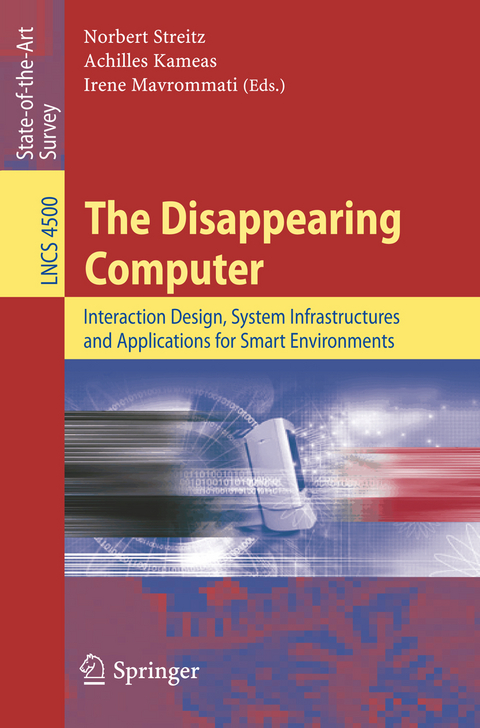
The Disappearing Computer
Springer Berlin (Verlag)
978-3-540-72725-5 (ISBN)
"The-computer-as-we-know-it" will have no role in our future everyday lives. This is the position taken in this book which elaborates how it will be replaced by a new generation of technologies, moving computing off the desktop and ultimately integrating it with real world objects and everyday environments. Computing becomes thus an inseparable part of our everyday activities while simultaneously disappearing into the background. It becomes a ubiquitous utility taking on a role similar to electricity - an enabling but invisible and pervasive medium revealing its functionality on request in an unobtrusive way and supporting people's everyday activities.
As members of the Steering Group of the EU-funded Disappearing Computer research initiative, the editors of this book successfully assembled a collection of 13 elaborate chapters and three forewords that address the issues and challenges in this area. All authors are prominent researchers who set out investigating, developing and deploying future, people-centred smart environments. This book provides a unique combination of concepts, methods and prototypes of ubiquitous and pervasive computing reflecting the current interest in smart environments and ambient intelligence.
Excerpts from the three forewords for the book:
Thierry van der Pyl and Thomas Skordas from the European Commission state that: The Disappearing Computer initiative anticipated and pioneered the concept of ambient intelligence ... and allowed to advance the boundaries of what is possible with the computer today.
Gregory Abowd from GeorgiaTech in the US writes about this research: While substantial progress was shown on the creation of information artefacts, it is the new behaviors and user experiences that promise long-term impact.
Finally, Emile Aarts from Philips Research comments on the relationship of ambient technology and people's behavior: "This current volume undoubtedly provides a majorcontribution to fill up this gap of knowledge."
I: Interacting within Smart Spaces.- Smart Artefacts as Affordances for Awareness in Distributed Teams.- From the Disappearing Computer to Living Exhibitions: Shaping Interactivity in Museum Settings.- Opening the Digital Box for Design Work: Supporting Performative Interactions, Using Inspirational Materials and Configuring of Place.- Spatial Computing and Spatial Practices.- II: Designing for the Home and Social Activities.- Co-designing Communication Technology with and for Families - Methods, Experience, Results and Impact.- Assembling Connected Cooperative Residential Domains.- Intrusiveness Management for Focused, Efficient, and Enjoyable Activities.- III: System Architecture and Infrastructures.- Towards Ubiquitous Computing Applications Composed from Functionally Autonomous Hybrid Artifacts.- Towards Dynamic and Cooperative Multi-device Personal Computing.- An Attention-Based Architecture for Context Switch Detection.- IV: Augmenting Physical Artefacts.- Emerging Sounds for Disappearing Computers.- Electronically Functional Fibre Technology Development for Ambient Intelligence.- Augmented Paper: Developing Relationships Between Digital Content and Paper.
From the reviews:
"The main topic of this book, has been successfully carried out in a variety of settings and activities, such as work environments, health, home, and leisure, to support human collaboration and cooperation. ... The targeted audience is HCI and computer science (CS) specialists who are involved in ubicomp research. Moreover, the book may be useful in HCI, computer-supported collaborative work (CSCW), information technology (IT), and related courses for teaching case studies and the state of the art of ubiquitous computing." (Miguel Garcia Ruiz, Computing Reviews, Vol. 50 (1), January, 2009)
| Erscheint lt. Verlag | 10.5.2007 |
|---|---|
| Reihe/Serie | Information Systems and Applications, incl. Internet/Web, and HCI | Lecture Notes in Computer Science |
| Zusatzinfo | XVIII, 304 p. |
| Verlagsort | Berlin |
| Sprache | englisch |
| Maße | 155 x 235 mm |
| Gewicht | 492 g |
| Themenwelt | Mathematik / Informatik ► Informatik ► Betriebssysteme / Server |
| Mathematik / Informatik ► Informatik ► Theorie / Studium | |
| Schlagworte | Accessibility • Adaptive Interfaces • ambient displays • Ambient Intelligence • Architecture • Assistive Technology • augmented paper • augmented reality • collaborative computing • Computer • context-awareness • context modeling • Dom • Embedded Technologies • Haptic Devices • HCI • Human-Computer interaction • Information Society • Intelligent interfaces • interactive applications • personalization • shared environments • social awareness • spatial computing • ubiquitous computing • Usability • usage scenarios • user-centered systems • User Interfaces • Virtual Reality |
| ISBN-10 | 3-540-72725-6 / 3540727256 |
| ISBN-13 | 978-3-540-72725-5 / 9783540727255 |
| Zustand | Neuware |
| Haben Sie eine Frage zum Produkt? |
aus dem Bereich


